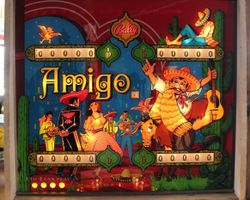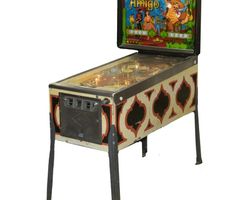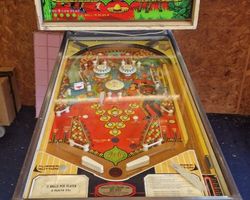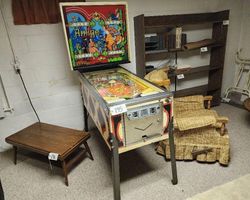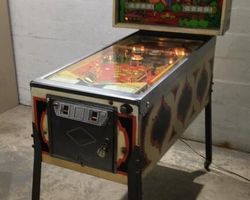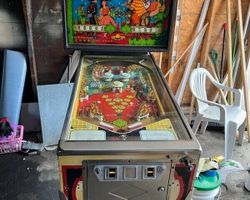Amigo

Average Prices: USD $300 to $800
Produced: May, 1974
Production Run: 4,325 units
Machine Type: Electro-mechanical
Players: 4
Design by: Greg Kmiec
Art by: Dick White
Step onto the playfield of Amigo, an electro-mechanical (EM) pinball machine that emerged from the prolific Bally Manufacturing Corporation in May 1974. This four-player machine, designed by Greg Kmiec with artwork by Dick White, stands as a notable example of mid-70s pinball, characterized by its straightforward yet engaging gameplay and a distinct visual identity centered around themes of dancing, music, and Mexican culture. Bally produced 4,325 units of Amigo (model number 993), making it a moderately common title that found its way into arcades and entertainment venues worldwide.
A particular curiosity surrounding Amigo is its unique backbox design, often referred to as "inverted." Unlike typical Bally backboxes of the era, the front frame of Amigo's backbox is wider at the bottom than at the top, creating a small ledge at the base of the backglass. This distinctive aesthetic, as noted by collectors, was particularly prevalent in games distributed in Italy and Germany, often featuring German instructions, suggesting a strong international presence for this specific production run. While this structural peculiarity adds a touch of trivia, it reflects Bally's willingness to experiment with cabinet forms during a period of rapid evolution in pinball machine design.
Signature Features and Design
Amigo presents a playfield rich with the hallmarks of classic EM pinball. Dominating the upper playfield are three pop bumpers, positioned to keep the ball lively and unpredictable. Below these, two slingshots on either side redirect the ball with force. Four standup targets and four rollover buttons are strategically placed to offer distinct shot opportunities and progressive scoring. A single kick-out hole, located centrally or to the right, serves as a crucial target for significant points and activating game features.
A standout element, and one of Amigo's most celebrated features, is its spinning target. This interactive component, positioned prominently, was a relatively novel inclusion for Bally at the time and became a central mechanic of the game's scoring strategy. The playfield also incorporates a right outlane ball return gate, offering a reprieve from an otherwise draining shot, and an up-post between the two flippers. This up-post acts as a temporary ball saver or a strategic block, adding a layer of control for players. The machine utilizes mechanical reels for score display, characteristic of EM games, and delivers auditory feedback through three chimes and a knocker, providing satisfying punctuation to key scoring events.
The artwork by Dick White on Amigo is frequently described as colorful, vibrant, and visually striking. It depicts scenes evoking traditional Mexican festivities, complete with figures dancing and singing. This visual style contributes significantly to the machine's overall aesthetic appeal, creating an atmosphere that aligns with its title and theme. However, it is important to acknowledge that this visual theme, while vibrant, employs stereotypical caricatures which have drawn criticism over time for reinforcing problematic representations. Despite this, the artistic execution itself is detailed and energetic, contributing to the machine's distinctive character.
Playfield and Mechanics
The playfield layout of Amigo is designed for a direct and flowing gameplay experience, characteristic of Greg Kmiec's approach to EM design. The upper section features the cluster of three pop bumpers, which, when lit by specific shots, provide rapid, unpredictable ball movement and score accumulation. Below the bumpers, the four rollover buttons are arranged to encourage controlled shots through lanes, often leading into the main playfield area.
Central to the playfield's design and gameplay strategy is the spinning target. Achieving this shot, particularly after lighting it, is paramount. The kick-out hole, typically positioned to the right or center, is another key target that not only awards points but often lights the spinner for maximum scoring potential. Successful shots into the right lane or loop frequently light the spinner, creating a rewarding loop for players who can consistently hit this specific path.
The lower playfield houses the two flippers, strategically placed to provide control and precision for hitting the various targets and lanes. The up-post situated between the flippers offers a crucial last-ditch save or a brief pause in play, allowing players to regain control. The right outlane ball return gate, activated after a successful spinner shot, serves as a welcome safety net, returning the ball to play rather than draining it. The overall aesthetic is enhanced by a simple yet effective lighting scheme that highlights active targets and scoring opportunities, guiding the player's focus without overwhelming the visual space. The bold, illustrative artwork covers the entire playfield, immersing players in the machine's intended festive atmosphere.
Gameplay Dynamics
Amigo's gameplay mechanics are rooted in the simplicity and directness that defines the EM era, yet they offer a surprising depth of strategy for those who seek to master its nuances. The core objective revolves around maximizing the score, primarily through the highly satisfying spinner shot. The ruleset is intuitive: light the spinner, then hit it repeatedly for significant points. Each rotation of the spinner can award up to 1000 points, making it the most lucrative target on the playfield.
Progression in Amigo typically involves hitting a series of standup targets or rolling over designated buttons to light various playfield features, including the pop bumpers and, most importantly, the spinner. The kick-out hole is also a vital shot, frequently activating the spinner and contributing to the player's bonus. The bonus system is a notable feature for its time, accumulating points throughout a ball and then awarding them at the end. On balls three and five, this accumulated bonus is automatically doubled, adding a layer of strategic anticipation and a potential for massive point totals.
One common player strategy involves focusing on lighting the spinner as quickly as possible and then repeatedly aiming for it to "roll" the score. Experienced players often find this a highly satisfying loop, leading to high scores and extra balls. While some players might find the game becomes repetitive due to this straightforward objective, others appreciate the pure, unadulterated challenge of perfecting this shot. The game is often perceived as having a good flow, with the ball generally staying in motion and providing a fast-paced experience, except for the brief pause when the ball enters the kick-out hole. Adjusting game settings, such as playfield incline, can significantly alter the challenge, preventing scores from being too easily rolled and encouraging more precise play.
Reception and Legacy
Amigo generally garners a positive reception within the pinball community, particularly among enthusiasts of classic EM machines. Its core appeal lies in its straightforward, accessible ruleset and the deeply satisfying experience of lighting and repeatedly hitting the spinner. Players often describe the game as fun, engaging, and even relaxing, a testament to its pure gameplay loop. The vibrant artwork, despite its thematic issues, is frequently praised for its visual appeal and lively nature, contributing to the machine's overall charm. The fast playfield action and good ball flow are also cited as strong points, providing a dynamic experience that keeps players invested.
However, the machine is not without its criticisms. The most significant and recurring negative feedback centers on its theme and artwork, which are widely perceived as racist due to their stereotypical portrayal of Mexican culture. This aspect is a major drawback for many, overshadowing the machine's gameplay strengths. From a pure gameplay perspective, some players find Amigo can be too easy, leading to potential repetitiveness once the spinner strategy is mastered, with the possibility of rolling the score multiple times on a single ball. Minor gripes include the automatic double bonus on certain balls, which some feel removes a layer of player agency. Furthermore, the right side of the playfield can sometimes feel "boxy," making certain shots challenging, especially if the flippers are not optimally tuned.
Despite these weaknesses, Amigo holds a notable place in pinball history. It is recognized as one of Bally's earlier machines to prominently feature a spinner as a central scoring mechanic, a feature that would become a staple in future designs. Its combination of an extra ball opportunity, an on-playfield special, a spinner, an up-post, and right outlane ball return gates demonstrates a robust formula for EM gameplay that proved highly engaging. Amigo's legacy endures as a "players' game," appreciated for its direct competition and the inherent satisfaction of its well-executed core mechanic. For those seeking an accessible yet strategically rewarding EM experience, Amigo continues to offer a compelling play.
Sponsored Links
 Ebay Listings
Ebay Listings
 Auction Results
Auction Results
| Cost | Location | Date |
|---|---|---|
| EUR €2,499 |  Bayern, Germany Bayern, Germany |
23 May, 2025 |
| GBP £356 |  Ashford, United Kingdom Ashford, United Kingdom |
04 March, 2025 |
| EUR €1,650 |  Bayern, Germany Bayern, Germany |
07 August, 2024 |
| USD $810 |  Florida, United States Florida, United States |
17 January, 2024 |
| EUR €794 |  Nordrhein-Westfalen, Germany Nordrhein-Westfalen, Germany |
16 January, 2024 |
| USD $600 |  Ohio, United States Ohio, United States |
10 October, 2023 |
| EUR €680 |  Baden-Württemberg, Germany Baden-Württemberg, Germany |
03 September, 2023 |
| EUR €1,190 |  Rheinland-Pfalz, Germany Rheinland-Pfalz, Germany |
01 September, 2023 |
| USD $615 |  Ohio, United States Ohio, United States |
04 June, 2023 |
| USD $600 |  United States United States |
02 June, 2023 |


Private Policy · Search Website · Contact Us
As an eBay Partner, we may earn a commission from qualifying purchases made through links on this site, at no additional cost to you.
All trademarks and copyrighted materials remain property of their respective owners. All other content copyright 2007 - 2025 Pinpedia.

